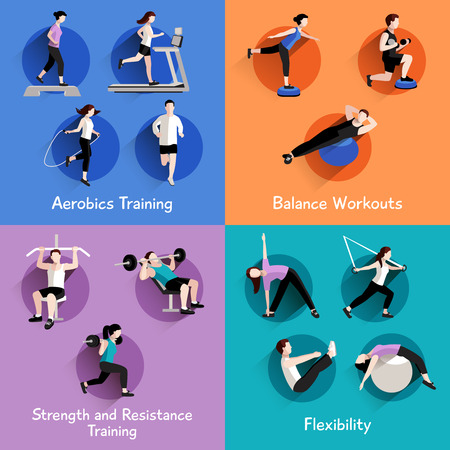

Ideally, strength training and conditioning are done on separate days to maximize strength capacity, but if they must be squeezed in together there is a methodology to consider.
“I have plenty of time in my schedule to exercise”…said nobody, EVER!!! How, then, does one optimize both conditioning and strength training in an efficient manner? Let’s find out.
Blending Formats
I often tell my clients that there is no need for them to pay me to hold their hand as they perform cardio. They can engage in conditioning workouts on different days than those that we have dedicated to strength training together. This has always made sense to them financially and appeals to my desire to focus on the weights when we are working as a trainer/client team.
However, I am fully aware that there are a number of individuals for whom time is a serious constraint, and who wish to combine conditioning with strength training as a timesaving maneuver. Is this a wise thing to advocate?
As it turns out, research seems to have much to say on the topic. Both types of exercise are indeed necessary for a complete training profile, including endurance, fat burning, strength building, muscularity and overall conditioning. However, in planning out strategic exercise formats, it is important to keep in mind how the body reacts differently to each type of training.
Mind the Interference
The Interference Phenomenon refers to the way in which adaptation mechanisms in the body compete with and interfere with each other, very often witnessed when cardio is performed concurrently with strength training. The result is often poor performance and less-than-expected body composition outcome.
Glycogen depletion and protein breakdown are 2 key processes that may cause such interference. A serious weightlifting session followed immediately by cardio significantly impairs strength capacity. Experts feel it is best to engage in cardio on alternate days than strength training, thereby allowing ample time for glycogen replenishment.
Creative Combinations
If conditioning and strength training must occur on the same day, careful planning can go a long way toward achieving positive results in both areas. Rather than couple lifting with low-intensity cardio performed for at least 20 minutes, 3x/week, aim for pairing strength training with very high-intensity short bursts of cardio. Eccentric cardio motions tend to cause more muscle damage. Therefore, when combining conditioning and strength training, think in terms of cardio moves that are concentric, such as cycling or weighted sled sprints.
Accentuating the Positive
Strength training can actually help endurance athletes offset the catabolic nature of such exercise, specifically the issue of elevated cortisol levels. Anaerobic forms of exercise may help reset the hypothalamic-pituitary axis so that it becomes more responsive, ultimately improving cortisol balance.
7 Day Concurrent Training Plan
In an effort to maximize results in both conditioning and muscular growth, here is an example of a training plan for a 7-day time period:
Monday: Lower-body Strength Training (quads, calves, hamstrings, abs)
Tuesday: Upper-body Strength Training (back, chest, shoulders, biceps, triceps)
Wednesday: Cardio
Thursday: Upper-body Strength Training
Friday: Lower-body Strength Training
Saturday: Cardio
Sunday: Rest
This particular protocol offers a perfect blend of weight training and cardio conditioning. Each muscle group will get worked twice in a week (upper/lower), which has been proven to be the most efficient training frequency for hypertrophy, utilizing the basic 3 exercises/body part, 3 sets of 8-10 repetitions.
Such a program also allows for 2 cardio sessions per week, which can still elicit considerable adaptations without risking a negative impact on weight training performance. Finally, this plan also figures in a total rest day for each body part; every muscle group will get at least 48 hours of rest within the 7-day cycle.
Power Athletes Should Avoid Concurrent Training
There is one unique exception to this general rule. Pure power athletes should avoid concurrent training at all costs since it leads to significantly reduced power by way of impairing velocity and rate-of-force development. By helping clients understand the science behind the different forms of exercise, we can guarantee greater results for them in both areas, thereby offering total workout success.
References
1.http://main.poliquingroup.com/ArticlesMultimedia/Articles/Article/1337/Why_You_Should_Not_Train_Strength_&_Cardio_At_The_Same_Time.aspx
2.https://www.muscleandstrength.com/articles/concurrent-training
3.https://www.strongerbyscience.com/cardio-and-lifting-cardio-wont-hugely-impact-your-gains-in-the-short-run-and-may-be-beneficial-for-strength-and-size-in-the-long-run/
4.https://breakingmuscle.com/learn/combining-strength-and-cardio-training-does-it-work
5.http://www.burnthefatinnercircle.com/members/Cardio-Training-Does-Not-Interfere-With-Resistance-Training.cfm
6.https://www.issaonline.edu/blog/index.cfm/2016/do-cardio-and-strength-training-actually-work-against-each-other
7.https://drjohnrusin.com/cardio-to-support-muscle-strength-development/






